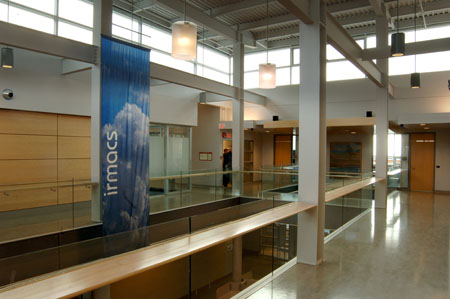FAQs

Location
Q1. Is the IRMACS Centre part of the Department of Mathematics/Faculty of Science/Faculty of Applied Science at Simon Fraser University?
A: No, it is not. The IRMACS Centre is not attached to any SFU department, faculty, or school. The Centre reports directly to the SFU Vice President Research. The IRMACS Centre currently hosts over fifty research projects led by researchers that come from the Faculty of Applied Science, Faculty of Arts and Social Sciences, Faculty of Education, Faculty of Health Sciences, and the Faculty of Science.
Research Projects and Membership
Q2. I am an SFU faculty member and I would like to apply for a research project at the IRMACS Centre. What I'm supposed to do?
A: Learn more about hosting a project at IRMACS and then submit the application form. The IRMACS Management Committee will consider your application and it will let you know about its decision approximately two weeks later.
Q3. I am considering applying for a research project at the IRMACS Centre. What does the Centre offer to its members?
A: To all its members, the IRMACS Centre provides computer access, desk space, technical and administrative support, access to all IRMACS infrastructure, and events hosted by IRMACS.
The IRMACS community is truly interdisciplinary. It consist of about 300 members that come from a number of disciplines and all walks of academic life. As an IRMACS member, you will meet faculty at all levels of seniority, post-doctoral-fellows, graduate and undergraduate students. IRMACS members include SFU researchers and visitors from all around the world.
Q4. Do I need to pay for using the IRMACS facilities?
A: Yes... If you are an IRMACS member, then you or your Project Leader will be charged an annual fee for your usage of the IRMACS facilities. This fee includes all technical and administrative support, desk space, access to IRMACS infrastructure, and allows you to book any of the IRMACS seminar or meeting rooms at no additional charge. If you are a dedicated member, i.e. you have an assigned desk during your stay at the IRMACS Centre, the annual charge is higher. Learn more at Become a Member.
If you are not an IRMACS member, learn more about booking an event.
Collaboration
Q5. What is Collaboration?
A. Collaboration is the process of working together to accomplish a task. From an IRMACS standpoint, when we talk about collaboration we really mean DISTRIBUTED, SYNCHRONOUS collaboration. The goal of the IRMACS collaboration infrastructure is to support researchers by bringing the right people together, with the right data, at the right time.
Q6. What do you mean by Distributed Collaboration?
A. By Distributed Collaboration, we mean collaborating with colleagues at a distance. IRMACS provides researchers with access to a range of tools to help them work with colleagues at remote institutions, whether across town or around the world.
Q7. What do you mean by Synchronous Collaboration?
A. By Synchronous Collaboration, we mean collaborating with colleagues at the same time. The IRMACS collaboration technologies are targeted at supporting remote research meetings, seminars, and training.
Q8. Why do I need collaboration?
A. You might not. With that said, if you are working with researchers at other institutions, the IRMACS collaboration infrastructure might be able to help you. Our goal is to help you perform your research more effectively by helping you to communicate with remote colleagues more effectively, create more effective distributed research groups, and helping to build new research relationships.
Q9. What collaboration technologies do you support?
A. We support a number of technologies, including H323 video conferencing, AccessGrid video conferencing, and VRVS collaboration tools. In addition, we support an instant messaging server that uses the Jabber protocol.
Q10. How do I find out more about collaboration?
A. We have an extensive set of web pages that provide details on the technologies we support. Please refer to the Collaboration web page for more details.

